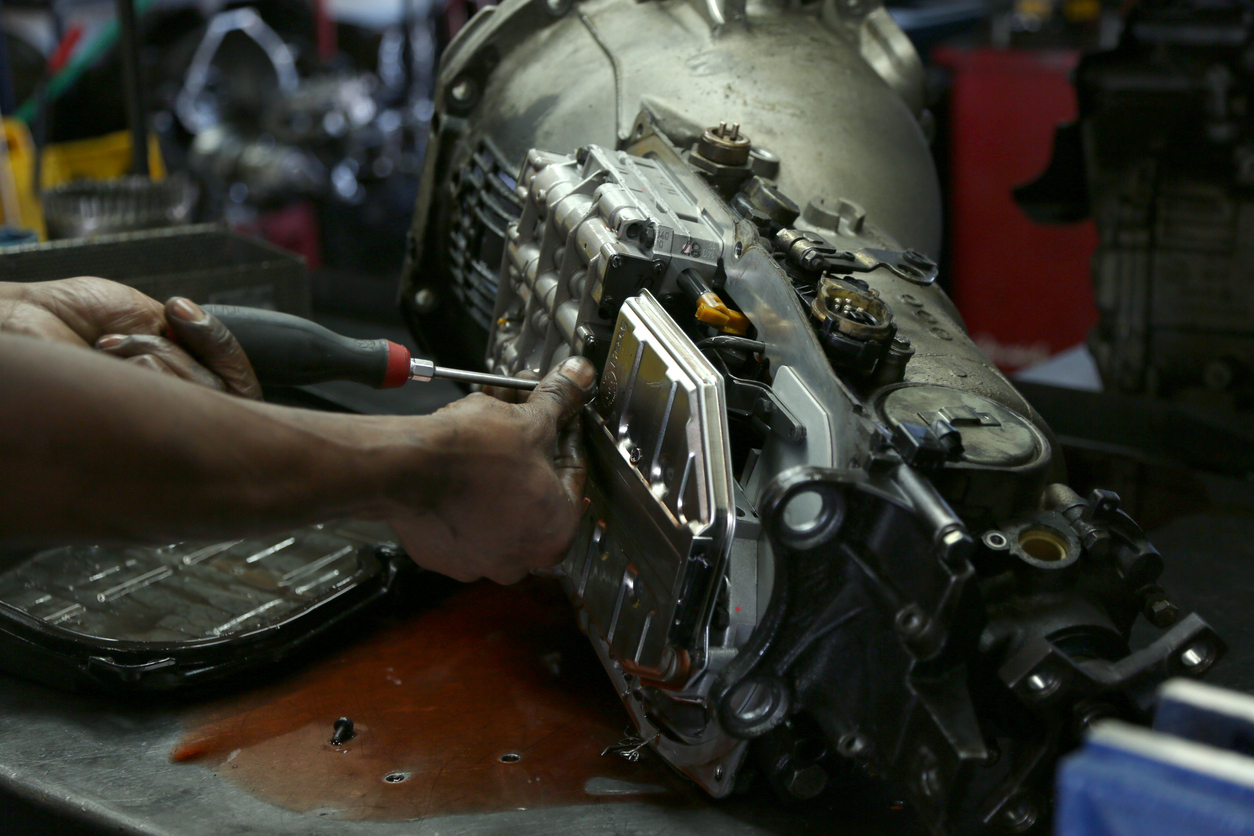Causes and Fixes for Transmission Leaks

A car’s transmission has a very important role: it helps ensure that the engine’s power gets transferred appropriately to other parts without going too fast or too slow for what the driver needs. Without a transmission regulating the power your wheels get, you either have no way to move your vehicle forward or no control of how fast or slow your wheels are spinning. Kind of makes you appreciate that transmission a little more, doesn’t it!
One integral part of your car’s transmission is the transmission fluid, which lubricates the moving parts in your transmission and provides the pressure needed to make sure everything works efficiently. While your transmission fluid should be replaced every 60,000 to 100,000 miles (depending on your vehicle’s make) car owners sometimes find themselves needing a transmission repair before the milestone ever pops up. How do you know if you need transmission service? Are there typical symptoms? Yes!
Typical Symptoms of a Transmission Leak
You can tell if your transmission is leaking if you notice any of the following signs:
- The level is “low” on the dipstick
- Gear slippage while accelerating (feels like a hesitation or brief loss of power)
- The dashboard warning light has come on
- Dark spots on the driveway (usually pink or red)
- Sounds of grinding or clunking gears
- Noticeable change/increase in vibration
- The smell of burning oil
These are just a few examples of what you may experience when there is a leak in your transmission. If you suspect your system may be leaking, seek help from one of our expert auto mechanics immediately to determine the specific cause.
Common Causes of Transmission Leaks
There are nearly ten (maybe more) causes of a transmission leak. In today’s blog, we’ll do a countdown of the top three most common causes. Drum roll, please!
Common Cause #3: Damaged Bell Housing
Your transmission is covered, protected, and supported by the bell housing. The bell housing is also where the engine connects to the transmission. It’s a vital part of your car. If it is damaged or cracked in any way, it has the potential to leak. Cracking can happen due to many different reasons:
- Driving roughly over rocky roads
- Striking something very hard with the bottom of your car
- A stone or other hard object gets propelled and strikes the bell housing
- Low or improper gearing
- Worn transmissions or engine mounts
While the crack will lead to a leak, ignoring a cracked transmission bell housing will only lead to a larger crack and inevitable structural failure, causing your transmission and engine to drop completely, and leading to even more damage and very expensive repairs.
Common Cause #2: Worn Seals or Gaskets
Over time, the seals and gaskets in your transmission will begin to wear out and crack with normal use. Routine inspections of your transmission’s parts should be inspected every few years to replace them before any leaks form.
Even if your seals or gaskets are to blame for your car’s transmission leak, the replacement of the part is a quick and easy repair. Gaskets often cost less than $20!
Common Cause #1: Loose Transmission Pan
Loose transmission pans are a common culprit of leaky transmissions and are usually caused by a loose bolt or plug that wasn’t properly tightened or secured after a transmission flush. The loose component needs to be fixed and the missing fluid replaced.
What Does the Transmission Pan Do?
Your automatic transmission fluid relies on your vehicle’s transmission pan to:
- Store the transmission fluid
- Provide fluid pressure to the system
- Lubricate the transmission’s parts
- Keep the fluid cooled between 175 and 225 degrees
- Reduce the number of contaminants
- Pull out particles with a magnet
Twelve quarts is the average amount of fluid a transmission pan holds, but some vehicles can even utilize up to 36 quarts of fluid! Only half of the transmission fluid is ever kept in the pan; the rest flows throughout the transmission cooling and lubricating the mechanisms. This is an important reason why having a full transmission flush is essential to preserving the health of your car’s transmission. A full flush cleans the pan as well as all the internal components!
How to Fix Your Transmission Leaks
The easiest way to fix your transmission is to bring it into your local auto repair shop for help locating the cause and finding a reliable solution. Some of the most common causes of car problems can be traced back to leaks in your transmission, and repairs can range from simply tightening a bolt or loose drain plug to replacing a damaged bell housing.
After a Leak is Fixed, a Flush is Needed
Our local auto repair shops always recommend a complete system flush after your repair. We use special machines that pump all the old fluid out of the vehicle. Drain and fill services only replace what’s in the pan, so a flush is needed to completely refresh all the fluid in the system. Does your vehicle need a transmission drain and fill service or a full transmission fluid flush? The answer depends on the mileage of your cart and how regularly the transmission was serviced. Our auto experts can inspect your transmission and its fluid to determine the best course of action for your car’s ongoing maintenance and repair.
Request Your Transmission Service Today!
When your car needs transmission service, choose none other than Christian Brothers Automotive for help! We help our customers prevent transmission damage early on, stopping issues before they become major problems.
Simply replacing the transmission fluid when the owner’s manual specifies goes a long way in protecting your car, so we’ll make sure to do that and so much more to maintain your car’s performance and reliability. We also back our services with our Nice Difference Warranty, offering some of the best promises in the industry.
The honest, quality service you’ll receive at Christian Brothers Automotive will keep your car in tip-top shape – locate your closest CBA auto repair shop and call today to schedule your visit!
This blog was written in May 2013, and updated in August 2023, to reflect current industry standards and best practices.


[1].jpg)
sunwash-tech-with-customer.png)

